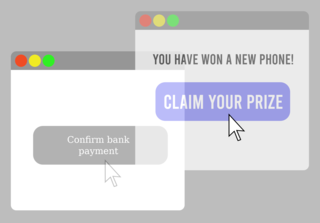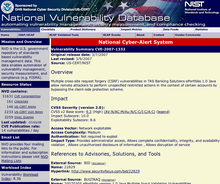In information security, a confused deputy is a computer program that is tricked by another program into misusing its authority on the system. It is a specific type of privilege escalation. The confused deputy problem is often cited as an example of why capability-based security is important.
Cross-site scripting (XSS) is a type of security vulnerability that can be found in some web applications. XSS attacks enable attackers to inject client-side scripts into web pages viewed by other users. A cross-site scripting vulnerability may be used by attackers to bypass access controls such as the same-origin policy. During the second half of 2007, XSSed documented 11,253 site-specific cross-site vulnerabilities, compared to 2,134 "traditional" vulnerabilities documented by Symantec. XSS effects vary in range from petty nuisance to significant security risk, depending on the sensitivity of the data handled by the vulnerable site and the nature of any security mitigation implemented by the site's owner network.
URL redirection, also called URL forwarding, is a World Wide Web technique for making a web page available under more than one URL address. When a web browser attempts to open a URL that has been redirected, a page with a different URL is opened. Similarly, domain redirection or domain forwarding is when all pages in a URL domain are redirected to a different domain, as when wikipedia.com and wikipedia.net are automatically redirected to wikipedia.org.
Code injection is the exploitation of a computer bug that is caused by processing invalid data. The injection is used by an attacker to introduce code into a vulnerable computer program and change the course of execution. The result of successful code injection can be disastrous, for example, by allowing computer viruses or computer worms to propagate.

In computing, the same-origin policy (SOP) is a concept in the web application security model. Under the policy, a web browser permits scripts contained in a first web page to access data in a second web page, but only if both web pages have the same origin. An origin is defined as a combination of URI scheme, host name, and port number. This policy prevents a malicious script on one page from obtaining access to sensitive data on another web page through that page's Document Object Model (DOM).
Session poisoning is a method to exploit insufficient input validation within a server application. Typically a server application that is vulnerable to this type of exploit will copy user input into session variables.
In computer network security, session fixation attacks attempt to exploit the vulnerability of a system that allows one person to fixate another person's session identifier. Most session fixation attacks are web based, and most rely on session identifiers being accepted from URLs or POST data.

Cross-site cooking is a type of browser exploit which allows a site attacker to set a cookie for a browser into the cookie domain of another site server.
In computer science, session hijacking, sometimes also known as cookie hijacking, is the exploitation of a valid computer session—sometimes also called a session key—to gain unauthorized access to information or services in a computer system. In particular, it is used to refer to the theft of a magic cookie used to authenticate a user to a remote server. It has particular relevance to web developers, as the HTTP cookies used to maintain a session on many websites can be easily stolen by an attacker using an intermediary computer or with access to the saved cookies on the victim's computer. After successfully stealing appropriate session cookies an adversary might use the Pass the Cookie technique to perform session hijacking. Cookie hijacking is commonly used against client authentication on the internet. Modern web browsers use cookie protection mechanisms to protect the web from being attacked.

HTTP cookies are small blocks of data created by a web server while a user is browsing a website and placed on the user's computer or other device by the user's web browser. Cookies are placed on the device used to access a website, and more than one cookie may be placed on a user's device during a session.

HTTP header injection is a general class of web application security vulnerability which occurs when Hypertext Transfer Protocol (HTTP) headers are dynamically generated based on user input. Header injection in HTTP responses can allow for HTTP response splitting, session fixation via the Set-Cookie header, cross-site scripting (XSS), and malicious redirect attacks via the location header. HTTP header injection is a relatively new area for web-based attacks, and has primarily been pioneered by Amit Klein in his work on request/response smuggling/splitting.
JSONP, or JSON-P, is a historical JavaScript technique for requesting data by loading a <script> element, which is an element intended to load ordinary JavaScript. It was proposed by Bob Ippolito in 2005. JSONP enables sharing of data bypassing same-origin policy, which disallows running JavaScript code to read media DOM elements or XMLHttpRequest data fetched from outside the page's originating site. The originating site is indicated by a combination of URI scheme, hostname, and port number.

Clickjacking is a malicious technique of tricking a user into clicking on something different from what the user perceives, thus potentially revealing confidential information or allowing others to take control of their computer while clicking on seemingly innocuous objects, including web pages.
Cross-application scripting (CAS) is a vulnerability affecting desktop applications that don't check input in an exhaustive way. CAS allows an attacker to insert data that modifies the behaviour of a particular desktop application. This makes it possible to extract data from inside of the users' systems. Attackers may gain the full privileges of the attacked application when exploiting CAS vulnerabilities; the attack is to some degree independent of the underlying operating system and hardware architecture.
Content Security Policy (CSP) is a computer security standard introduced to prevent cross-site scripting (XSS), clickjacking and other code injection attacks resulting from execution of malicious content in the trusted web page context. It is a Candidate Recommendation of the W3C working group on Web Application Security, widely supported by modern web browsers. CSP provides a standard method for website owners to declare approved origins of content that browsers should be allowed to load on that website—covered types are JavaScript, CSS, HTML frames, web workers, fonts, images, embeddable objects such as Java applets, ActiveX, audio and video files, and other HTML5 features.
Browser security is the application of Internet security to web browsers in order to protect networked data and computer systems from breaches of privacy or malware. Security exploits of browsers often use JavaScript, sometimes with cross-site scripting (XSS) with a secondary payload using Adobe Flash. Security exploits can also take advantage of vulnerabilities that are commonly exploited in all browsers.
BREACH is a security vulnerability against HTTPS when using HTTP compression. BREACH is built based on the CRIME security exploit. BREACH was announced at the August 2013 Black Hat conference by security researchers Angelo Prado, Neal Harris and Yoel Gluck. The idea had been discussed in community before the announcement.
Secure cookies are a type of disable HTTP cookie that have Secure attribute set, which limits the scope of the cookie to "secure" channels. When a cookie has the Secure attribute, the user agent will include the cookie in an HTTP request only if the request is transmitted over a secure channel. Although seemingly useful for protecting cookies from active network attackers, the Secure attribute protects only the cookie's confidentiality. An active network attacker can overwrite Secure cookies from an insecure channel, disrupting their integrity. This issue is officially referred to as Weak Integrity. However, some browsers, including Chrome 52 and higher and Firefox 52 and higher, forgo this specification in favor of better security and forbid insecure sites (HTTP) from setting cookies with the Securedirective.
Server-side request forgery (SSRF) is a type of computer security exploit where an attacker abuses the functionality of a server causing it to access or manipulate information in the realm of that server that would otherwise not be directly accessible to the attacker.
Cross-site leaks, also known as XS-Leaks, are a class of web security attacks. This class of attacks allows an attacker to access sensitive information about a user's interactions with other websites by leveraging long-standing information leakage issues inherent to the design of the web platform, such as the use of Cascading Style Sheets (CSS) attributes or timing information related to the web cache to reveal a user's previous browsing habits.



